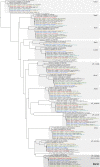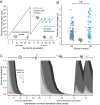Host-selected mutations converging on a global regulator drive an adaptive leap towards symbiosis in bacteria
- PMID: 28447935
- PMCID: PMC5466423
- DOI: 10.7554/eLife.24414
Host-selected mutations converging on a global regulator drive an adaptive leap towards symbiosis in bacteria
Abstract
Host immune and physical barriers protect against pathogens but also impede the establishment of essential symbiotic partnerships. To reveal mechanisms by which beneficial organisms adapt to circumvent host defenses, we experimentally evolved ecologically distinct bioluminescent Vibrio fischeri by colonization and growth within the light organs of the squid Euprymna scolopes. Serial squid passaging of bacteria produced eight distinct mutations in the binK sensor kinase gene, which conferred an exceptional selective advantage that could be demonstrated through both empirical and theoretical analysis. Squid-adaptive binK alleles promoted colonization and immune evasion that were mediated by cell-associated matrices including symbiotic polysaccharide (Syp) and cellulose. binK variation also altered quorum sensing, raising the threshold for luminescence induction. Preexisting coordinated regulation of symbiosis traits by BinK presented an efficient solution where altered BinK function was the key to unlock multiple colonization barriers. These results identify a genetic basis for microbial adaptability and underscore the importance of hosts as selective agents that shape emergent symbiont populations.
Keywords: Euprymna scolopes; Vibrio fischeri; evolutionary biology; experimental evolution; genomics; infectious disease; microbiology.
Conflict of interest statement
The authors declare that no competing interests exist.
Figures





















Similar articles
-
Hybrid Histidine Kinase BinK Represses Vibrio fischeri Biofilm Signaling at Multiple Developmental Stages.J Bacteriol. 2021 Jul 8;203(15):e0015521. doi: 10.1128/JB.00155-21. Epub 2021 Jul 8. J Bacteriol. 2021. PMID: 34031036 Free PMC article.
-
The Histidine Kinase BinK Is a Negative Regulator of Biofilm Formation and Squid Colonization.J Bacteriol. 2016 Sep 9;198(19):2596-607. doi: 10.1128/JB.00037-16. Print 2016 Oct 1. J Bacteriol. 2016. PMID: 26977108 Free PMC article.
-
Bacterial Quorum-Sensing Regulation Induces Morphological Change in a Key Host Tissue during the Euprymna scolopes-Vibrio fischeri Symbiosis.mBio. 2021 Oct 26;12(5):e0240221. doi: 10.1128/mBio.02402-21. Epub 2021 Sep 28. mBio. 2021. PMID: 34579565 Free PMC article.
-
Host/microbe interactions revealed through "omics" in the symbiosis between the Hawaiian bobtail squid Euprymna scolopes and the bioluminescent bacterium Vibrio fischeri.Biol Bull. 2012 Aug;223(1):103-11. doi: 10.1086/BBLv223n1p103. Biol Bull. 2012. PMID: 22983036 Review.
-
Quorum sensing in the squid-Vibrio symbiosis.Int J Mol Sci. 2013 Aug 7;14(8):16386-401. doi: 10.3390/ijms140816386. Int J Mol Sci. 2013. PMID: 23965960 Free PMC article. Review.
Cited by
-
Microbial evolution and transitions along the parasite-mutualist continuum.Nat Rev Microbiol. 2021 Oct;19(10):623-638. doi: 10.1038/s41579-021-00550-7. Epub 2021 Apr 19. Nat Rev Microbiol. 2021. PMID: 33875863 Free PMC article. Review.
-
Modulation of Quorum Sensing as an Adaptation to Nodule Cell Infection during Experimental Evolution of Legume Symbionts.mBio. 2020 Jan 28;11(1):e03129-19. doi: 10.1128/mBio.03129-19. mBio. 2020. PMID: 31992622 Free PMC article.
-
Vibrio fischeri Biofilm Formation Prevented by a Trio of Regulators.Appl Environ Microbiol. 2018 Sep 17;84(19):e01257-18. doi: 10.1128/AEM.01257-18. Print 2018 Oct 1. Appl Environ Microbiol. 2018. PMID: 30030225 Free PMC article.
-
Natural Strain Variation Reveals Diverse Biofilm Regulation in Squid-Colonizing Vibrio fischeri.J Bacteriol. 2019 Apr 9;201(9):e00033-19. doi: 10.1128/JB.00033-19. Print 2019 May 1. J Bacteriol. 2019. PMID: 30782630 Free PMC article.
-
Experimental Microbiomes: Models Not to Scale.mSystems. 2019 Jul 30;4(4):e00175-19. doi: 10.1128/mSystems.00175-19. mSystems. 2019. PMID: 31363014 Free PMC article.
References
-
- Altura MA, Heath-Heckman EA, Gillette A, Kremer N, Krachler AM, Brennan C, Ruby EG, Orth K, McFall-Ngai MJ. The first engagement of partners in the Euprymna scolopes-Vibrio fischeri symbiosis is a two-step process initiated by a few environmental symbiont cells. Environmental Microbiology. 2013;15:2937–2950. doi: 10.1111/1462-2920.12179. - DOI - PMC - PubMed
MeSH terms
Substances
LinkOut - more resources
Full Text Sources
Other Literature Sources
Molecular Biology Databases

